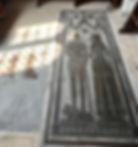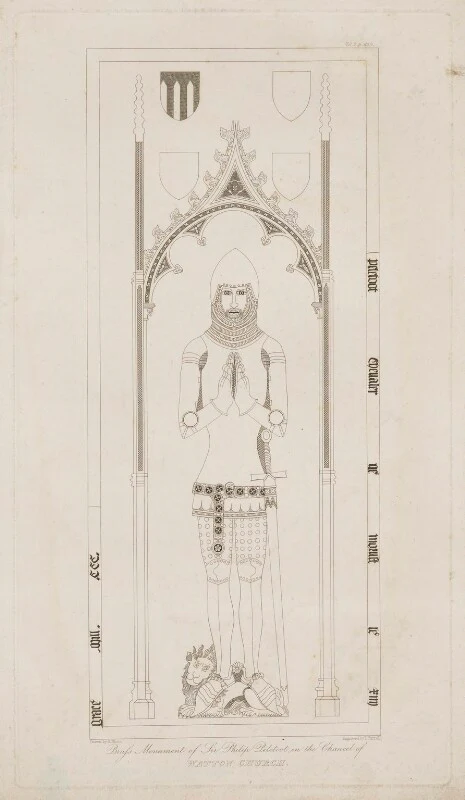Knights and their ladies - some medieval monumental brasses in England
- Michael Smith
- May 13
- 6 min read
Updated: Oct 8

Medieval monumental brasses in England provide an interesting insight into the fashions, aesthetics and religious inclinations of those they commemorate. Spanning a period from the 1270s to the 1680s they represent an astonishing record of English social life, covering ecclesiastics, men in armour, women, civilians and even shrouded corpses.
Although the use of brass memorials spanned many centuries, they their apogee in England in the fourteenth century; in this post I will look at few examples from between 1300 and 1550, focusing on knights and their wives.
The examples I include in this article are from Essex, Hertfordshire and Northamptonshire although, as the Reverend Herbert W Macklin shows in his Monumental Brasses (George Allen & Unwin, 1913), their use is extensive across the country.
Sir John de la Pole and Joan Cobham, Chrishall, Essex – 14th century

This magnificent brass, dating from ca. 1370-80 is one of the finest in England, depicting Sir John de la Pole and his wife, clasping hands beneath a triple canopy decoration. Sir John is shown dressed in plate armour beneath a tight-fitting jupon, narrowed at the waist in the style of the times. He wears a simple bascinet with mail aventail while at his feet is a magnificent lion, representative of bravery.
His wife, Joan, wears a tight-fitting dress of many buttons, with a low neck and long, pendulous tippets attached to her sleeves at the elbow. A dog, representative of loyalty, rests at her feet.
Other, smaller brasses are to be found nearby. Dating from 1450-1480, they depict a husband and wife and a single lady although their quality fails to match that of the de la Pole memorial.
Sir Philip Peletoot, Saints Andrew & Mary, Watton-at-Stone, Hertfordshire – 14th century

The brass to Sir Philip Peletoot (d. 1361) was restored in the nineteenth century. Standing beneath a single canopy with four shields shown below (of which only one survives in situ), he is dressed similarly to Sir John de la Pole with a tight-fitting jupon and an open-faced bascinet. Like Sir John, his jupon is fashionably decorated with scalloped edges.
Of note is Sir Philip's leg armour. His upper thighs are dressed in padded cloth (possibly reinforced with metal plates) with metal studs, suggestive of an earlier date than Sir John; as with the latter, he stands atop a lion at his feet.
Sir Philip's death in 1361 may relate to the second outbreak of the Black Death which ravaged England in that year; that year also saw the death of Humphrey de Bohun, patron of The Romance of William and the Werewolf.
Note: I was not able to gain access to the church to take a recent photograph so the image is from a drawing in the National Portrait Gallery, copies of which are for sale at the NPG shop, here. I will upload a photograph in due course.
John de Cressy and William Wylde, St Mary the Virgin, Dodford, Northamptonshire – early 15th century

This church contains an impressive series of effigies and memorials, including one to a medieval woman made from oak. Of significance are two brasses: John de Cressy (d. 1414) and his wife Cristina, and William Wylde (d. 1422) and his wife Cecilia.
It can be seen that both knights wear armour which is earlier than the examples at Sandon, Albury and Stanstead Abbotts and are wearing their helmets. The rondels on both suits of armour are circular; these features disappear in later suits where pauldrons cover the shoulder and armpit area more completely.
While both Cristina and Cecilia wear different clothes to each other, a comparison with those worn by Elizabeth Fitz-Geffrey suggests a less exaggerated aesthetic, tending towards the ecclesiastical rather than the secular.
It is possible both wives may be shown as if in mourning for their husbands although Elizabeth wears a broad headdress, albeit not as decorative as those of the later fifteenth century.
Unknown knight and lady, St Mary’s, Albury, Hertfordshire – late 15th century

The main monument at St Mary’s is the much damaged fourteenth century stone effigy to Sir Walter at Lea and his wife but nearby can be found an attractive brass of an ; unknown knight and lady.
Dating to the late fifteenth century (Macklin dates it to 1475 although it may be later), the brass shows a fully armoured knight in an open faced helmet standing above a dog. His hands, without gauntlets, show him animated in discussion with his wife, who faces him. His wife, in a low-cut dress and large headdress appears to be praying.
Sir John Fitz-Geffrey and wife, All Saints, Sandon, Hertfordshire – late 15th century

A high-quality fifteenth century brass, dated ca. 1480, commemorates John Fitz-Geffrey, who is shown beneath a shield bearing his family arms of a bull.
Sir John, bare headed but with his head resting on a large battle helm, is fully dressed in plate armour with a bull also shown at his feet. His wife, Elizabeth, in a large headdress, is attired similarly to the lady at Albury although her dress is less revealing; she wears a distinctive belt to which is attached a long pendant chain with a flower head forming the belt-chape at the end.
The brass also includes a small depiction of the couple’s six daughters; the corresponding brass to their (three?) sons is missing.
Unknown knight, St James, Stanstead Abbotts, Hertfordshire – 16th century

The armour of this figure suggests a knight of the late 15th-early 16th Century. Macklin has argued that brasses in this period show men with bare heads, first with short hair and then with long. By the Tudor period (1485-1558), he writes, “figures are clumsily drawn and are often out of proportion”.
This is certainly the case with this memorial. Although the brass shows very close attention to contemporary armour and style it may well be that the brass is produced to a template in the manner of a “production line”.
Unfortunately, the brass no longer retains any information as to who it is intended to represent (although the indentation for the panel is shown). The upper arms appear to indicate decorations applied to the armour, suggestive of status; he is standing with a dog at his feet..
Of interest is the treatment of the pauldrons; that to his right (sword bearing) arm, reveals chainmail in the armpit, possibly to enable greater flexibility. The pauldron to his left arm may suggest less flexibility, possibly indicative of a jousting plate in replacement of a shield.
And finally - can you help?

I hope you have found this brief tour or medieval brasses of interest; I will be uploading further articles in due course.
In the meantime, can you help? I was given the attached brass rubbing by a friend a few years ago but they were not able to tell me the church from which it was taken.
As you can see, it closely resembles that of Sir Philip Peletoot and probably dates from the second quarter of the fourteenth century; I'd love to know who it is and from where it was taken!
Gallery of monumental brasses in Essex, Hertfordshire and Northamptonshire
About the author, Michael Smith

I am a British translator and illustrator of medieval literature. I am also an accomplished printmaker, with work in private collections worldwide.
My books, including a translation of Sir Gawain and the Green Knight and the Alliterative Morte Arthure, are available through all the usual outlets. My translation of The Romance of William and the Werewolf was published in 2024. All my books feature my own linocut prints as their illustrations.
To find out more about me, please click here
For more details of my books and how to purchase signed copies, click here.























